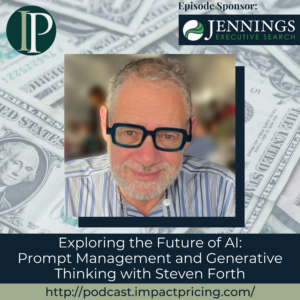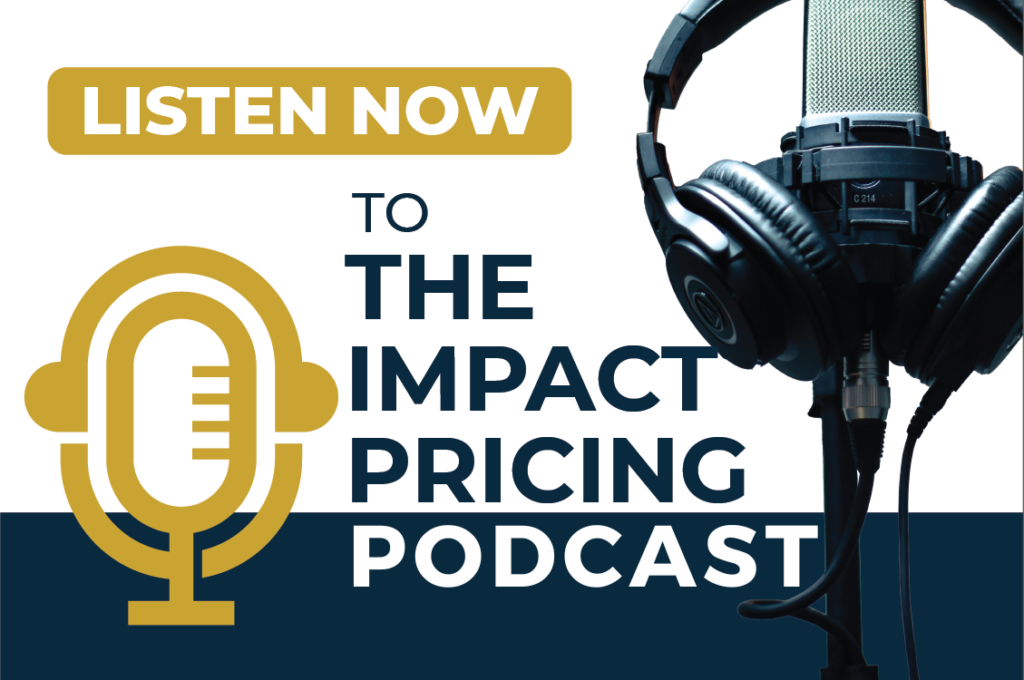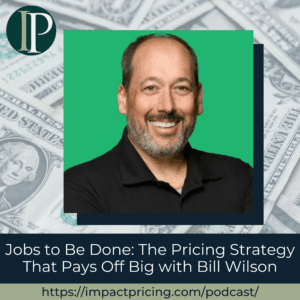Steven Forth is Ibbaka’s Co-Founder, CEO, and Partner. Ibbaka is a strategic pricing advisory firm.
In this episode, Steven discusses how AI, particularly transformer models, is revolutionizing business strategies by automating complex tasks like value modeling and scenario planning, making them more efficient. He emphasizes the importance of leveraging AI to explore frameworks and generate innovative solutions, such as using AI to better understand industry problems. Steven also highlights the ongoing development of prompt orchestration tools, which will soon become essential for managing AI workflows and optimizing the use of multiple models.
Podcast: Play in new window | Download
Why you have to check out today’s podcast:
- Discover how AI is transforming traditional frameworks like value modeling, scenario planning, and pricing, making complex processes faster and more efficient.
- Gain insights on how AI can help you better understand problems and create innovative solutions, ultimately improving your decision-making process.
- Dive into emerging concepts like prompt orchestration and how AI is evolving, giving you the tools to enhance your AI workflows for maximum effectiveness.
“Create a series of prompts, create a series of context documents that you can reuse and explore the framework in ways that you never could before and find ways of applying it.”
– Steven Forth
Topics Covered:
02:10 – How no single AI model can meet all needs, thus, advocating for multiple model for diverse perspectives and specialized capabilities
03:11 – Distinguishing between diffusion models and transformer models
05:46 – How does a transformer model work
07:28 – Understanding the [LQMs] Large Quantitative Models, [RAG] Retrieval Augmented Generation and challenges faced by companies like Pros in leveraging customer-owned data
11:39 – How Wolfram/Alpha uses mathematical reasoning to validate and simplify equations and highlighting the emergence of reasoning models for complex problem-solving
15:34 – Steven reflecting on his increasing reliance on AI tools, how they are transforming his thinking, and the need to embrace these technologies as vital partners in enhancing exploration, communication, and decision-making
17:17 – How generative AI enables more dynamic and efficient approaches to scenario planning
23:29 – Emphasizing how leveraging AI with established frameworks accelerates complex tasks like building value models
25:13 – Learning ‘prompt orchestration’ to optimize prompt sequences and responses
26:52 – Explaining Perplexity’s limitations in generating complete outputs
Key Takeaways:
“It used to take Ibbaka between 40 and 60 hours of work by a highly trained person to build a value model. It now takes us less than two hours to build a better value model than we could have done before.” – Steven Forth
People/Resources Mentioned:
- Geoffrey Hinton: https://en.wikipedia.org/wiki/Geoffrey_Hinton
- Bloomberg: https://www.bloomberg.com/asia
- Attention is All You Need paper: https://en.wikipedia.org/wiki/Attention_Is_All_You_Need
- Sam Altman: https://en.wikipedia.org/wiki/Sam_Altman
- Karen Chiang: https://impactpricing.com/podcast/467-minimize-churn-and-boost-your-net-dollar-retention-with-karen-chiang/
- Porter’s 5 Forces: https://en.wikipedia.org/wiki/Porter%27s_five_forces_analysis
- Clayton Christensen: https://en.wikipedia.org/wiki/Clayton_Christensen
- William Gibson: https://en.wikipedia.org/wiki/William_Gibson
- Perplexity AI: https://www.perplexity.ai
- ChatGPT: https://chatgpt.com
- You.com: https://you.com
- Hugging Face: https://huggingface.co
Connect with Steven Forth:
- LinkedIn: https://www.linkedin.com/in/stevenforth/
- Email: [email protected]
Connect with Mark Stiving:
- LinkedIn: https://www.linkedin.com/in/stiving/
- Email: [email protected]
Full Interview Transcript
(Note: This transcript was created with an AI transcription service. Please forgive any transcription or grammatical errors. We probably sounded better in real life.)
Steven Forth
Create a series of prompts, create a series of context documents that you can reuse and explore the framework in ways that you never could before and find ways of applying it.
[Intro / Ad]
Mark Stiving
Welcome to Impact Pricing, the podcast where we discuss pricing, value, and the attention-based relationship between them. I’m Mark Stiving, and I run bootcamps that help companies get paid more. Our guest today is the one and only Steven Forth, and I’m actually going to tell you three things about him today. He runs Ibbaka, a value-based software and consulting company. He’s probably the leading thinker in AI and pricing on the planet, and he has been on so many times. By now, I can call him my friend. Welcome, Steven.
Steven Forth
Mark and we absolutely call each other friends.
Mark Stiving
Excellent. Glad to hear it. So I wanted to talk today just about AI and who else would I talk to about it other than you. Usually when we talk about AI, it’s how are we going to use it in pricing? And maybe we’ll get to that towards the end of the podcast. But I’ve just been so confused by all of the different AI models that are out there and all of the different possible uses for AI. I thought, who better to talk to about all this than you? Because you know it way better than I do. So, before I ask any specific questions, I feel like pontificating.
Steven Forth
Okay. Well, just to briefly pontificate two sorts of thoughts. One is, I am hugely enthusiastic about generative AI so treat everything I say skeptically and second is, I think it’s really important to understand that no one model is going to serve all of your purposes. So, any solution that is saying this is the model is I think wrong out of the box. So there are going to be lots of different models just as if you wanted to talk to a doctor. You want to be able to get a second opinion. If you want to ask a generative AI model something, you want to be able to get a second opinion. And each of the major models has its own personality almost, and is better at some things than others.
Mark Stiving
I think that’s a great place to start. What do you think are the best models out there, and how should we be… which one should we be using for what types of information?
Steven Forth
So I think that the first thing to realize is that the AI world today, it’s all deep learning, and it’s all based on Geoffrey Hinton and his crew’s innovations around deep learning. But there are some very big differences in the types of models. So if you are interested in generating video or music or art, you’re relying primarily on a diffusion model. And diffusion models are their own, I will say their own separate thing. So diffusion models are a really important part of AI. and they’re not what we are usually talking about when you and I are talking,
Mark Stiving
Does that include graphics as in, pictures that people create?
Steven Forth
Yes. But I check about every month to see the progress on generating actually useful graphs or useful, not just graphs, but sort of useful information. And my test case for this is UML, the unified modeling language. So every month or so I check progress on generating UML and I don’t care what kind of models are doing it. But right now as of December, 2025, I would say that all of these models are useless for generating UML and that sort of thing.
Mark Stiving
Yeah. Quick correction. It’s 2024 still, but that’s okay.
Steven Forth
I’m anticipating it.
Mark Stiving
Yes.
Steven Forth
You got to live a little bit in the future. But so, there’s diffusion models. I think when you and I are talking, we’re mostly talking about transformer models and when you mention the attention-based relationship between them there’s a famous paper in 2017 from Google called Attention is All You Need. And it’s actually that paper that is the origin of most of the things that we think of like GPT, Claude, Llama, and Mistral models and Grok models from xAI, those are all transformer models. Now, there is work being done to connect transformer models and diffusion models in some really interesting ways. That will be a big part of what drives innovation over the next few years and there’s also a lot of work being done on building models that are much more numerical-based. And these things are called large quantitative models.
Mark Stiving
But before we jump there, tell me about, what is a transformer model? Is there a way to describe it other than it’s what you and I talk about?
Steven Forth
Yeah. So basically a transformer model at its heart is doing a very simple thing. It chunks information up into what it calls tokens. So there’s tokenization. For each token there’s a set of embeddings, and embeddings are the semantic and syntactic properties of that token. And all it’s trying to do is to predict which token should come next. So that’s really all transformer models are doing. They’re saying, if I have this set of tokens, what token is likely to come next? And a token is like a part of a word. So it’s like, depending on which tokenization you’re using, but it’s, for example, upstanding would be two tokens, one for up and one for standing. So, tokenization actually matters a lot. And each of these different models does the tokenization slightly differently.
Mark Stiving
And the one big difference between this and diffusion is we’re talking specifically about language now.
Steven Forth
Language and all the things that language encompasses, like code and musical notation and some aspects of math. Large language models are getting better at math, but they’re still, essentially probabilistic. And math is good for understanding probability, but math itself is not probabilistic. Yeah. It’s not highly probable that one plus one equals two.
Mark Stiving
Yeah. It would be factual.
Steven Forth
Yes. I have somewhere which I’ll try to, I’ll dig it out and share it with you. I have a long thread that I did with GPT on does one plus one equal two.
Mark Stiving
Nice. Okay. So let’s go to the quantitative models.
Steven Forth
Well, this is a new thing, relatively new thing. So large quantitative models or LQMs are something we’re going to see a lot of over the next 12 to 18 months. And they’re using the principles of deep learning primarily with Numerative data. So I think Bloomberg has done quite a bit of work on this. Bloomberg has an LQM because anyone who has a lot and remember, you have to have a lot, a lot, a lot of data to build a transformer model. It’s fun to make a model on a very small data set. And I’ve built a couple of models myself just using a very restricted data set. But because it’s all probabilities, you get interesting, but usually fairly bizarre results. So, in order to build an LQM, you need access to an enormous amount of data.
Now, once people have the LQM, just like with the large language models, then you can do really interesting things. You can augment them. So, I think that when most of us are doing interest or sophisticated work with large language models, we’re using some form of RAG architecture, Retrieval Augmented Generation, where we are giving the model a lot of additional context so that it understands, I’m using the word understand loosely so that it understands what we’re trying to get at. So most professional uses of generative AI and transformer models rely on some form of RAG architecture.
Mark Stiving
And is this what, say Pros, Zilliant, Vendavo, these guys are using the pricing systems?
Steven Forth
No, they predate all of this. One of the things that they are struggling with is to figure out how, what, where they play in this reimagined world. And I would assume that they are looking at LQM and deep learning approaches to the data sets because they have lots of data, I’m not sure that they have access to, and the rights to, even if they have the data, I’m not sure what their rights to use that data look like to really generate LQMs. Someone like Bloomberg has an enormous amount of financial data, right? That they’ve gathered, organized and curated, or that’s public sector, public data that they can work from. Take Pros, Pros manages a huge amount of data, and has some very sophisticated artificial intelligence approaches to understanding and manipulating that data. I’m not sure that they are legally allowed to aggregate it to build an LQM, though, because that data belongs to their customers, not to them.
So, I’m not sure what they’re doing. We should get them on, and have a conversation with them. But I’m sure that they are looking at ways to do this and they can take inferences that they draw from their existing AIs and use that in a retrieval augmented generation, a RAG style architecture to combine it with large language models, to get some really interesting new functionality. I’m sure. So we’re going to see some super interesting innovations from these, I hope. We are going to see some super interesting innovation from these companies over the next year or so, as they do mashups of large language models and their existing AIs. And then the open question, I think is, can they then go beyond that to the next generation of AI and build LQM. But I suspect that what’s going to happen is that it’ll be sort of like what we do with, Retrieve Augmented Generation, that you’ll have a large LQM from Bloomberg or OpenAI or whoever yeah because all these guys are building these models and we’ll find interesting ways of integrating.
Mark Stiving
We talked a while ago, and you had mentioned to me Wolfram AI. Wolfram/Alpha. Is that an LQM? Or where does that fit in our hierarchy?
Steven Forth
No, it’s a completely different beast. Wolfram is the company that makes Mathematica. And over the last decade at least, they’ve been building something called Wolfram/Alpha. Wolfram/Alpha takes mathematical reasoning, and not probabilistic reasoning, but actual mathematical reasoning and applies it to data. So as an example, one of the things that we do at Ibbaka is that we generate value models. So we now have a system for generating a value model. But remember we’re generating them using a transformer and a RAG assisted transformer architecture. So one of the things that we do is that we take those equations, we pass them to Wolfram/Alpha, and we ask Wolfram/Alpha. So we say, one, is this a valid equation? This equation is supposed to do X, Y, Z, does it do X, Y, Z? And we ask Wolfram/Alpha to answer to evaluate that. And then we ask Wolfram Alpha to simplify the equation. And those sorts of things, Wolfram/Alpha does far more reliably than any transformer model will ever do, I think. Now the emerging story in transformer models is reasoning models. So you’ve heard of OpenAI’s O1 models. At their conference last week, they were talking about O3, which is the next generation of O1 and they skipped O2. So, no, you were not sleeping and they had O2 when you missed it, they actually went from O1 to O3.
Mark Stiving
So that’s a marketing ploy. Go ahead.
Steven Forth
Yeah. The CEO Sam Altman explains why they did it, but it sounded something fairly silly. So who cares? Yes. But anyway, reasoning models are going to be a very big deal over the next two years because they provide far better results for the kind of complex problem that people like, such as you and I address in our daily work. So super interesting stuff. The other, and I know we’re not here today to talk primarily about pricing, but the other really interesting thing is going to be how are these things going to be priced? So here’s a crazy idea. How much would you pay for, let’s call it OpenAI O7. So, in the future when it’s even more capable, would you pay $50,000 a year or a hundred thousand dollars a year as a subscription to have something that is capable of assisting you? We think of these things as something we pay $20 or $200 a month for, but imagine that you had something that was capable of really doing deep reasoning. Would you pay a lot more for it? You might.
Mark Stiving
Yeah, I might.
Steven Forth
It would be like hiring a PhD, right?
Mark Stiving
Yeah. So, I know we’re not talking about pricing, but to me, this always comes down to the platform versus solution issue. Right? And as long as I’m paying for a platform, I’m paying 20 bucks a month. But if I’m going to buy a solution that’s really valuable to me, it depends on how much value it’s delivering.
Steven Forth
Yeah. And I have to have a use for that. I wouldn’t go and hire a PhD in applied mathematics, just because I felt like having a PhD in applied mathematics working for me. I have to have something for that person to do.
Mark Stiving
Somebody’s got to wash the dishes, Steven. Okay, so let’s jump back. I think we’re going to spend a bunch of time talking about transformer models for a second, if that’s okay. And I feel like I’m left behind. I feel like I’m not using AI well enough. I feel like other people are getting way ahead of me because they’re doing things I’m not doing. So what am I missing here? What should I be doing? And this is, by the way, for everybody who’s listening, right? I mean, we all feel the exact same way.
Steven Forth
Well, I think we, yeah, all of us do, because it’s rapidly changing when what these models can do is changing. So one of the things that I’ve noticed is that over the last six to nine months, I’ve become hugely dependent on having my AIs available. So, I generally have one or the other AI open in five or six different tabs at a time. So, I’ve gotten multiple threads. I call them threads. So a thread is a series of prompts. So I’ve got multiple threads running, sometimes they’re related to each other, and I’m cross pollinating the threads. And sometimes I’ve just got one. I need a new recipe for roasted cauliflower. So would be just a sort of blip that happens. So I’m using them constantly and I’m finding they’re changing how I think. So, and I’m not sure if I’m comfortable or happy with how they’re changing, how I think, either. So it’s something that I really want to talk to people about and introspect on over the next year to understand the changes this is causing in my own thinking. But I think we need to do this. We need to, if I believe anyway, as I said, be skeptical though that this is the future that we are all going to be heavily reliant on these to augment our own thinking and our ability to explore and communicate with people. So it helps to be all in.
Mark Stiving
Okay. So, give us an example besides the cauliflower recipe. Give us an example of something that you’re sitting there working and all of a sudden it’s like, oh, let me go ask AI that. What would you do?
Steven Forth
Okay. There are, that’s one scenario. I don’t think that’s the most interesting one. I do that constantly though. So I’m always looking for things or as I work questions are always surfacing. We were talking earlier about service as software. So services as a software is an idea that’s come up over the last three to six months as a new way of thinking about how AI is going to change services industries. So I went toAI. I think I was using which model was I using? I think I was using Llama in this case. And I asked what’s service as a software? So just start with a naive question. So sometimes it’s good to start with a naive question. I got very frustrated because it said, oh, you’re confused. Service as a software, software as a service. No, I’m not confused. You’re confused.
Mark Stiving
And if you said that it apologized to you, I’m sure.
Steven Forth
Yeah. Well, no, actually it took me a couple of nudges to get it to onto my frock. Sometimes I find working with these is like trying to coax a three-year-old.
Mark Stiving
Yes.
Steven Forth
But anyway, I’m constantly using it to explore ideas and help people understand ideas and how ideas are connected. But those aren’t the most interesting things I think. So, for me, I found if you can take a well-developed framework and two that I found really, really fruitful here are, scenario planning and concept blending, and use it to actually help you do those things. So, let’s take scenario planning as an example. So, scenario planning came out of work at The Rand in the sixties, was developed at Shell and a number of other organizations in the seventies and has become, its own discipline the ensuing time. Basically what you do is you say, ‘Okay, what are the things about the future that we can agree on?’
And turns out there’s not that much, but things like demographics are pretty well settled. Moore’s Law that the price was going to go down by half, and the capability of a semiconductor was going to double every 18 months. So, there’s a number of things that at least for over time horizons of 10 to 30 or to a hundred years we can agree on are pretty well set. But then there are other things that we don’t agree on or that we can’t know how the future is going to turn out. And these are critical uncertainties. And this scenario planning really consists of combining critical uncertainties in different ways to see what would happen depending on how the world turned out. So, to pick something that is still for some reason controversial climate change, so you can say that, we are going, that climate change is actually happening, or you can say it’s not, let’s just assume for the moment that there’s some doubt about that.
I don’t think there is, but some people do. So rather than argue whether climate change is happening or not, you say, ‘Okay, under this assumption it is, and under this assumption it isn’t.’ And then you combine that with another critical uncertainty and you can generate scenarios that way. The classic example is the scenarios that were generated about South Africa as it was as the ANC was taking power, an incredibly compelling piece of work. But anyway with generative AI, I can now create a series of prompts that allow me to rapidly generate critical uncertainties and combine them and compare them in a way that I couldn’t do a year ago. And it’ll allow me and my team and my community to rapidly explore different possible futures, in a way that I couldn’t in the recent past, and it’s just been mind blowing. Some years ago right when COVID was starting one of my colleagues, Karen Chang and I came up with something called Agile Scenario Planning, in which we said that in classic scenario planning, the focus is on the scenarios, in agile scenario planning, the focus is on the critical uncertainties and rapidly uncovering them and comparing them.
And we developed a process for this, and we did it with a couple of organizations, but it was too cumbersome. It’s not something that anyone ever adapted, including ourselves, but with generative AI, all of a sudden this becomes incredibly doable and light. So, whatever frameworks that you’ve worked with in the past I would suggest trying to figure out a way to turn them into a set of prompts and a set of contexts and start using them with AI. Maybe, you’re an old fashioned strategy geek, and Porter’s five forces model means everything to you. So you could turn that into a set of contexts and prompts and rapidly explore different industries or companies or categories, and use 5 Forces in a way that you couldn’t do a year ago.
Mark Stiving
I find that absolutely fascinating. And I’m doing a lot of that right now in some work I’m doing just to try to apply the frameworks I teach all the time to an industry that I don’t know that well. And it’s fascinating watching how it works out. But I want to share with you one more thing I do, and I have to say that everyone listening should be doing what I’m about to describe. And that is, I emphasize the problem. People have problems. Value comes from solving problems. And so rarely do people understand problems. Do companies understand problems? And so oftentimes when before I talk to a new client, I’ll go look at their website and I’ll say, ‘Hey, tell me a story about someone who buys this product.’ And it’s just a beautifully written story that says, ‘Here’s the problem these guys are dealing with.’ It’s like, you could do this yourself and have a much better understanding of the problems that you’re dealing with. But I get on these calls and understand the problems better than my clients do just because I use AI for that purpose.
Steven Forth
Yeah. And I think that that’s a great example, right? This is how people, knowledge professionals should be exploring AI, take a framework that is meaningful to you, it could be Porter’s 5 Forces, it could be Clayton Christensen’s disruptive innovation. Could be value-based pricing, could be scenario planning, there’s scads of these things out there. Create a series of prompts, create a series of context documents that you can reuse and explore the framework in ways that you never could before and find ways of applying it. Because it used to take Ibbaka between 40 and 60 hours of work by a highly trained person to build a value model. It now takes us less than two hours, to build a better value model than we could have done before. And most of that two hours is actually not the value modeling part. It’s building the context about the industry or the category and the solution. That’s what takes the time. And generating the value model once you have the right set of prompts and the right set of context documents, you’ve orchestrated your prompt management system to do this. This is fairly straightforward. And this is actually one of the places where we’re using Wolfram/Alpha, which we were talking about earlier, right? This is part of this process.
Mark Stiving
Okay. Last hard question for you. Help me with prompt management. I write new prompts every single time, and so it’d be really nice to have like a script maybe, or how do you do this if you’re going to use, if you’re going to try to apply the same framework over and over again?
Steven Forth
Yeah. So, I think there’s a simple way to do this, which is to just have a document or a spreadsheet where you keep your prompts and you iterate on them and improve them. So that’s something anyone can do and probably should do if they’re using AI professionally. Beyond that though we’re going to see over the next, it’s happening now. Remember William Gibson’s beloved quote, ‘The future is here, it’s just not evenly distributed.’ So, there is work happening right now on what I call prompt orchestration, which is taking a sequence of prompts, actually not one prompt, but taking a sequence of prompts knowing how they fit together, knowing how different models respond to the prompt and going through an iterative improvement cycle. The software to help you do that has been built. Stanford, I think, has a system that does that and other places are, and I expect it will become basic software that we all have and use within the next two or three years.
Mark Stiving
Yeah. I lied. I’m going to ask you one more hard question. So, quick story for you. I used to use ChatGPT almost exclusively. I switched to perplexity because I have access to all these other models all of a sudden when I do that. And then I was using Perplexity, it created a table for me, an Excel file. But it wouldn’t give me the Excel file. It said I had to have base code or something. So I went back to chatGPT, and it gave me my Excel file. Yep. So now tell me what’s going on?
Steven Forth
Well, Perplexity has the ability to access. So, what Perplexity does is mostly accessing other people’s models. So, it’s limited to what their APIs allow you to access. And there are cases where the models are able to do more than can be accessed and transferred through their APIs. So, it’s a super interesting business problem, right? So what is the balance of power between systems like Perplexity and you.com that allow you to access a half dozen different models, but they’re limited because they only get API access to those models. And people like anthrobots and OpenAI that are actually building the models, and so that they can do things that the people that are just accessing through their APIs can’t. So they only have their own models, but they can do more with those models. Whereas Perplexity has lots of models and allows you to compare models and get synergies out of what different models are good at, but it doesn’t have full access to the complete power of the models.
Mark Stiving
I hate to ask, how many are you subscribed to?
Steven Forth
Well this is now the largest, apart from people, this is our largest budget item. And so, everybody at my company has Perplexity. A subgroup has the OpenAI pro level, which is,well, is it expensive? Is $200 a month per person expensive or not?
Mark Stiving
Depends on what they get.
Steven Forth
It depends on what you’re doing with it, right? But we need access to O1. So, and that’s the best way to really get access to O1 unless you’re going to be using it at the API level, which has its own costs. And then we’re experimenting with you.com as well, because you.com has some slight differences in how the models are configured. And then additionally some of us, use models from Hugging Face, which has a huge collection of models available to it, most of which are, let’s be polite and say most of which are not interesting. But there’s jewels in there too. There’s some incredibly interesting models available on Hugging Face. And Hugging Face also provides access to things like Llama to any of the open source models. So, it’s a diverse environment out there. I hate to say it, but I think most of us are going to need to have something like Perplexity or you.com, and we’re also going to need direct access to one or more models. So we’re going to be spending a lot of money on this.
Mark Stiving
Steven, as always, this is brilliant. It just reminds me that I know so little. So, thank you very much for sharing what you know with us.
Steven Forth
Yeah, well there’s a lot for us to learn. 2025 is going to be an exciting year.
Mark Stiving
No doubt. So if anybody wants to contact you, how can they do that?
Steven Forth
Two ways. I am easy to find on LinkedIn, and I’m active on LinkedIn, so that is probably the best way. And for people on this podcast, I am happy to take your emails, Steven, S-T-E-V-E-N @ I-B-B-A-KA.com.
Mark Stiving
Excellent. And to our listeners, thank you very much for your time today. If you’ve enjoyed this just half as much as I did, please leave us a rating and a review. And if you have any questions or comments about this podcast or if your company needs help getting paid for their true value, feel free to email me, [email protected]. Now, go make an impact!
[Ad / Outro]
















